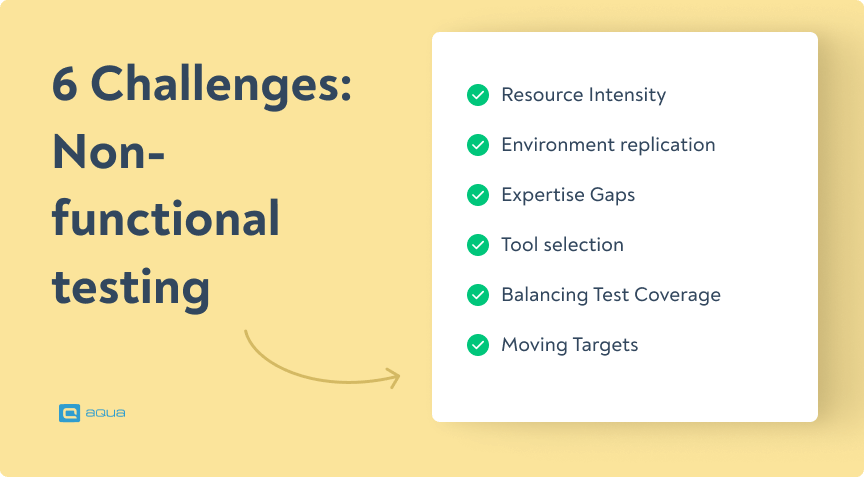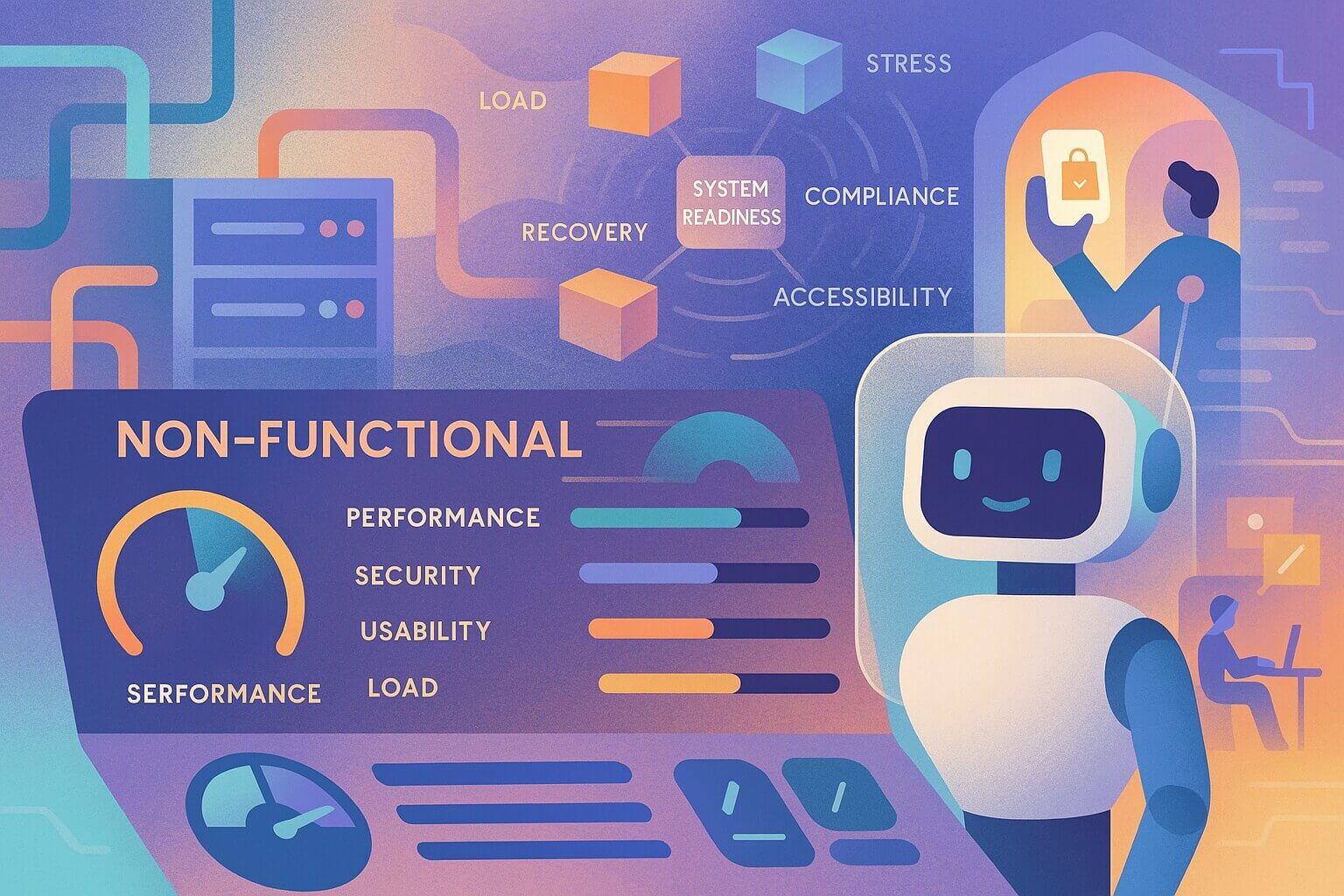Now, users expect applications that not only work but work well—systems that are fast, secure, and user-friendly. Non-functional testing has evolved from a “nice-to-have” to a critical component of the software development lifecycle, especially as user expectations continue to rise.
In this guide, we’ll break down what non-functional testing really means, why it matters to your QA team, and how you can implement it effectively. Consider this your backstage pass to creating software that doesn’t just function—it thrives.
What is Non-Functional Testing?
Non-functional testing evaluates the qualities of a system beyond its basic functions—it tests how a system performs rather than if it performs its intended tasks. While functional testing confirms whether your login button actually logs users in, non-functional testing checks if that login happens quickly, securely, and reliably.
Think of it this way: functional testing checks if your car starts, the brakes work, and the headlights turn on. Non-functional testing examines fuel efficiency, handling on wet roads, and comfort during a six-hour road trip.
Non-functional testing assesses aspects like:
- Performance and speed under various conditions
- Security against potential threats
- Usability and user experience
- Reliability and stability over time
- Compatibility across different platforms
- Scalability when user numbers grow
This type of testing reveals critical insights that directly impact user satisfaction and business success. A feature-packed application that crashes under heavy load or leaks sensitive data won’t win any fans, no matter how well it functions on paper.
Core Objectives of Non-Functional Testing
Non-functional testing goes beyond checking features—it ensures your software meets the expectations users don’t explicitly state but absolutely expect. Here’s what it aims to accomplish:
- Enhance User Experience: Users expect systems that are fast, intuitive, and reliable. Non-functional testing ensures your software feels as good as it works.
- Verify System Reliability: When your system faces unexpected situations—heavy traffic, server issues, or unusual user behavior—non-functional testing helps ensure it stays stable.
- Address Security Vulnerabilities: Before hackers find weaknesses, non-functional testing identifies security gaps and ensures sensitive data remains protected.
- Optimise Performance: By measuring response times and resource usage, non-functional testing pinpoints bottlenecks and opportunities for optimization.
- Ensure Compliance: Many industries have strict regulatory requirements for security, accessibility, and data handling. Non-functional testing helps verify that your software meets these standards.
The beauty of effective non-functional testing is its preventative nature—it catches issues before they impact real users, saving your team from emergency fixes and damaged reputations.
For effective non-functional testing, you need a robust test management system that will make life easy for you and your testing efforts. A prime example of this TMS is aqua cloud, an AI-powered solution with valuable features fit to your testing needs.
Aqua cloud goes beyond functional testing to support critical non-functional testing efforts—like performance, usability, and security validation. With native integrations to solutions like JMeter and seamless support for exploratory and session-based testing, you can simulate real-world load, uncover UX bottlenecks, and document unpredictable behaviors. aqua’s AI-powered features dramatically cut test setup time by generating test cases, test data and requirements creation in seconds. By centralising test management, linking tests to requirements, and providing traceable, real-time reporting, aqua ensures that issues like performance drops, confusing flows, or security anomalies are caught early—before they impact users.
Go beyond functional testing with 100% AI-powered solution
Types of Non-Functional Testing
Performance Testing
Performance testing examines how your system behaves under various load conditions. It’s the difference between an application that handles Black Friday traffic gracefully and one that crashes when featured in a popular blog post.
Types of performance testing include:
- Load Testing: Verifies system behavior under expected load conditions
- Stress Testing: Pushes systems beyond normal operating capacity to find breaking points
- Endurance Testing: Monitors system behavior during sustained periods of expected load
- Spike Testing: Examines system response to sudden, significant increases in load
Key metrics measured in performance testing include:
- Response time
- Throughput
- Resource utilization
- Maximum concurrent users
- Stability under load
A good performance test reveals not just if your system slows down, but exactly where the bottlenecks occur—whether in database queries, memory usage, or network limitations.
Usability Testing
Usability testing evaluates how intuitive and user-friendly your application is. It examines whether users can accomplish their goals efficiently and with satisfaction.
Key aspects of usability testing include:
- Navigation flow and intuitiveness
- Visual design and layout effectiveness
- Error handling and messaging clarity
- Accessibility for users with disabilities
- Overall user satisfaction
The most valuable usability tests often involve observing real users completing tasks while gathering qualitative feedback. This testing reveals whether your perfectly functional software will frustrate users in practice.
Security Testing
Security testing has become increasingly crucial as cyber threats evolve. It identifies vulnerabilities that could compromise your system’s integrity, confidentiality, or availability.
Security testing typically includes:
- Vulnerability Scanning: Identifying known security holes
- Penetration Testing: Simulating attacks to expose weaknesses
- Security Scanning: Analyzing network and system weaknesses
- Risk Assessment: Analyzing security risks and their potential impact
Effective security testing doesn’t just find vulnerabilities—it prioritizes them based on potential impact and exploitation likelihood, helping teams focus remediation efforts where they matter most.
Scalability Testing
Scalability testing determines if your application can effectively “scale up” to accommodate growth in users, data volume, or transaction rates.
This testing examines:
- Performance under increased user loads
- Database performance with growing data volumes
- System behavior when adding more resources
- Identification of scaling bottlenecks
Scalability testing helps prevent the awkward situation where your growing business becomes a victim of its own success—unable to serve new customers because systems can’t handle the growth.
Reliability Testing
Reliability testing ensures your system performs consistently without failure under specified conditions for a defined period.
Key reliability testing areas include:
- Recovery Testing: How well the system recovers from failures
- Failover Testing: Testing backup systems when primary systems fail
- Availability Testing: Measuring system uptime and accessibility
This testing is critical for applications where downtime means lost revenue, damaged reputation, or even safety risks.
Compatibility Testing
Compatibility testing verifies that your application works properly across different:
- Browsers and browser versions
- Operating systems
- Devices (desktop, tablet, mobile)
- Network environments
- Database systems
This testing prevents the “works on my machine” syndrome from affecting your end users, ensuring consistent experiences regardless of their technology setup.
Start with learning about non-functional requirements. That detail will guide you to an appropriate test plan for your particular case. You need to define traffic volume, rates, data sizing, and observability.
Think you understand why non-functional testing matters? Put your skills to the test in this interactive battle arena where you’ll defend a live system against real-world performance challenges, security attacks, and user experience issues – and watch your decisions impact system health in real-time.
⚔️ Performance Testing Battle Arena (Click to toggle)
Defend your system against performance challenges and learn why non-functional testing matters
Non-Functional Testing Parameters
When planning non-functional testing, you’ll need to establish clear parameters to measure success. Here’s a breakdown of key parameters to consider:
| Parameter | Description | Key Metrics |
|---|---|---|
| Performance | How quickly the system responds and processes requests | Response time, throughput, CPU/memory usage |
| Scalability | How effectively the system handles increased load | Performance at various user levels, resource utilization trends |
| Reliability | How consistently the system functions without failure | Mean time between failures (MTBF), recovery time |
| Availability | How often the system is operational and accessible | Uptime percentage, scheduled vs. unscheduled downtime |
| Usability | How intuitive and satisfying the system is for users | Task completion rates, error rates, satisfaction scores |
| Security | How well the system protects data and prevents breaches | Vulnerability counts, penetration test results |
These parameters should be defined with specific, measurable targets relevant to your business context. For example, rather than simply saying “the system should be fast,” specify “the checkout process must complete in under 3 seconds for 95% of users under peak load.”
For each parameter, consider:
- Baseline expectations (minimum acceptable level)
- Target goals (desired performance level)
- Measurement methods and tools
- Testing environments that accurately reflect production
Remember that these parameters often interact—pushing performance too far might impact reliability, and excessive security measures might affect usability. Finding the right balance is key.
Advantages of Non-Functional Testing
Implementing thorough non-functional testing brings numerous benefits to your development process and end product:
- Improved User Satisfaction: Users rarely complain about features working as expected—but they absolutely notice slow pages, frequent crashes, or confusing interfaces. Non-functional testing directly addresses the factors that drive satisfaction.
- Reduced Production Incidents: Finding and fixing performance bottlenecks, security vulnerabilities, and reliability issues before deployment dramatically reduces emergency fixes and unplanned outages.
- Better Resource Planning: Understanding how your system performs under various conditions helps you plan infrastructure needs, preventing both wasteful over-provisioning and risky under-provisioning.
- Competitive Advantage: Applications that are faster, more reliable, and more user-friendly than competitors’ offerings gain market share—even when feature sets are similar.
- Regulatory Compliance: Many industries have strict requirements for security, accessibility, and reliability. Non-functional testing helps ensure compliance, avoiding costly penalties and legal issues.
- Cost Savings: Finding issues early in development costs significantly less than fixing them after deployment. One study found that fixing a defect in production can cost 30 times more than addressing it during design.
The ROI of non-functional testing becomes particularly clear when you consider the business impact of alternatives—like customers abandoning slow checkout processes or the reputation damage from security breaches.
You can increase this ROI even more by using a robust TMS to supercharge your testing efforts.
Aqua cloud extends its capabilities beyond functional testing to robustly support non-functional testing domains such as performance, usability, and security. With native integrations to tools like JMeter, aqua enables realistic load and stress testing, ensuring your application performs optimally under various conditions. Its AI-powered features expedite the generation of test cases, requirements, and test data, significantly reducing setup time. By centralising both manual and automated tests, aqua provides comprehensive traceability and real-time reporting, allowing teams to identify and address issues like performance bottlenecks, usability challenges, or security vulnerabilities early in the development cycle.
Settle for excellence with 100% AI-powered, all–around TMS
Challenges in Non-Functional Testing
Despite its importance, implementing effective non-functional testing comes with several challenges:
- Resource Intensity: Many types of non-functional testing require specialized environments, tools, and expertise. Setting up performance testing infrastructure that accurately mimics production can be particularly resource-intensive.
- Environment Replication: Creating test environments that truly reflect production conditions is difficult, especially for performance and scalability testing. Without this, results may not predict real-world behavior.
- Expertise Gaps: Skills needed for security testing differ significantly from those needed for usability or performance testing. Finding or developing team members with cross-functional expertise can be challenging.
- Tool Selection: The market offers countless tools for different types of non-functional testing, making tool selection and integration complex.
- Balancing Test Coverage: With limited time and resources, determining which non-functional aspects deserve the most testing attention requires careful prioritization.
- Moving Targets: Requirements for performance, security, and other non-functional aspects often evolve throughout development, requiring continuous updates to test strategies.

When teams face time constraints, non-functional testing is often the first casualty—sacrificed to meet delivery deadlines despite the long-term risks this creates.
Functional testing validates that a business process that was developed in a system works. Non-functional testing are things like performance testing, disaster recovery testing, etc. Things that have to work to keep the system running, but don't represent functionality of that system.
Best Practices for Non-Functional Testing
To maximise the effectiveness of your non-functional testing efforts, consider these best practices:
- Start Early: Integrate non-functional testing from the beginning of the development process. Finding a performance issue during design is much cheaper than discovering it in production.
- Define Clear Requirements: Establish specific, measurable non-functional requirements. Rather than “the system should be secure,” specify “the system must prevent SQL injection attacks and encrypt all personally identifiable information.”
- Automate Where Possible: Many aspects of performance, security, and compatibility testing can be automated, allowing more frequent testing with less manual effort.
- Test in Production-Like Environments: Ensure your test environments closely mirror production in terms of data volume, network configuration, and infrastructure.
- Establish Baselines: Create baseline measurements for key metrics so you can identify performance degradation or improvements over time.
- Integrate with CI/CD: Include automated non-functional tests in your continuous integration pipeline to catch issues early.
- Use Cloud Resources: Use cloud-based testing platforms to simulate realistic load and traffic patterns without maintaining expensive testing infrastructure.
- Test with Real User Data Patterns: Base your performance testing scenarios on actual user behavior rather than theoretical usage patterns.
- Document and Track Results: Maintain a history of non-functional test results to identify trends and demonstrate improvements over time.
- Include Non-Functional Testing in Definition of Done: Make passing non-functional tests a requirement for completing work, not an optional extra.
By making non-functional testing a first-class citizen in your development process, you’ll avoid the common trap of dealing with performance, security, and usability as afterthoughts.
Conclusion
Non-functional testing might not get the spotlight as often as its functional counterpart, but it’s what separates good software from great software. While functional testing confirms your application does what it’s supposed to do, non-functional testing ensures it does it well—efficiently, securely, and in a way users genuinely enjoy.
As digital experiences continue to evolve, user expectations for performance, security, and usability have never been higher. Organizations that treat non-functional testing as a core part of their development process—rather than an optional add-on—will deliver superior products that stand out in crowded markets.


















